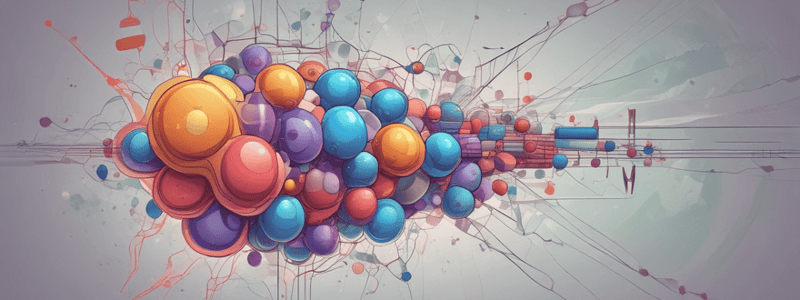Podcast
Questions and Answers
What is the term for the process by which the number of receptors in a cell is increased in response to repeated drug treatment?
What is the term for the process by which the number of receptors in a cell is increased in response to repeated drug treatment?
- Phosphorylation
- Desensitisation
- Up-regulation (correct)
- Downregulation
What is the term for the rapid development of tolerance to a drug?
What is the term for the rapid development of tolerance to a drug?
- Downregulation
- Tachyphylaxis (correct)
- Tolerance
- Desensitisation
What is the term for the process by which an agonist produces less effect the longer it remains in contact with the receptor?
What is the term for the process by which an agonist produces less effect the longer it remains in contact with the receptor?
- Downregulation
- Desensitisation (correct)
- Phosphorylation
- Up-regulation
What is the term for the study of the relationship between the dose of a drug and its effect?
What is the term for the study of the relationship between the dose of a drug and its effect?
What is the term for the process by which the effect of a drug is reduced due to repeated administration?
What is the term for the process by which the effect of a drug is reduced due to repeated administration?
What is the term for the process by which receptors are removed from the surface of the cell?
What is the term for the process by which receptors are removed from the surface of the cell?
What is the term for the study of how the body affects the drug, as opposed to how the drug affects the body?
What is the term for the study of how the body affects the drug, as opposed to how the drug affects the body?
What is the term for the process by which the number of receptors in a cell is reduced in response to repeated drug treatment?
What is the term for the process by which the number of receptors in a cell is reduced in response to repeated drug treatment?
What determines the potency of a drug?
What determines the potency of a drug?
Which type of antagonism is reversible?
Which type of antagonism is reversible?
What is the measure of the effectiveness of a drug in producing a maximum response?
What is the measure of the effectiveness of a drug in producing a maximum response?
What is the dose-response curve shifted to when there are spare receptors?
What is the dose-response curve shifted to when there are spare receptors?
Which of the following is a characteristic of an agonist?
Which of the following is a characteristic of an agonist?
What is the purpose of dose-response measurements?
What is the purpose of dose-response measurements?
What is the definition of a drug?
What is the definition of a drug?
What is the result of increasing doses of an agonist on a receptor?
What is the result of increasing doses of an agonist on a receptor?
What is pharmacodynamics?
What is pharmacodynamics?
What is the relationship between KD and affinity?
What is the relationship between KD and affinity?
What is the term for the attraction of a drug for binding to a receptor?
What is the term for the attraction of a drug for binding to a receptor?
What type of receptors are involved in fast neurotransmission?
What type of receptors are involved in fast neurotransmission?
What is the term for a ligand that produces a response when it binds to a receptor?
What is the term for a ligand that produces a response when it binds to a receptor?
What determines the maximum response that a drug can produce?
What determines the maximum response that a drug can produce?
What is the term for the ability of a drug to distinguish between different receptors?
What is the term for the ability of a drug to distinguish between different receptors?
What is the term for a substance that can cause birth defects?
What is the term for a substance that can cause birth defects?
Flashcards are hidden until you start studying
Study Notes
Pharmacodynamics
Potency and Efficacy
- Potency: the measure of the drug dosage needed to produce a particular therapeutic effect, determined by the strength of binding of a drug to a receptor or the receptor affinity for the drug.
- Efficacy: the measure of the effectiveness of a drug in producing a maximum response.
- Full agonists have high efficacy, while antagonists have no efficacy.
Dose-Response Measurement
- Used to determine accurate dosing needed when new drugs are formulated.
- Cannot use these measurements to calculate affinity only dosing.
- Agonists bind to receptors causing contractions, which are plotted, and increasing doses lead to increasing responses until two doses have an equal response.
Drug Antagonism
- Competitive (or surmountable) Antagonism: agonists and antagonists compete for the same receptor sites, and the maximal effect remains unchanged.
- Non-Competitive (or irreversible) Antagonism.
- Physiological Antagonism.
Molecular Aspects of Drug Action
- The number of receptors in a cell is not static but dynamic, with a high turnover of receptors as they are continuously removed or replaced.
- Repeated drug treatment may up-regulate or downregulate the receptor numbers.
Tolerance, Desensitisation, and Tachyphylaxis
- Tolerance: the same dose of drug, on repeated administration, produces less effect.
- Desensitisation: less effect is produced the longer the agonist remains in contact with the receptor.
- Tachyphylaxis: tolerance that develops very rapidly.
- Causes of desensitisation/tachyphylaxis/tolerance: change in receptors (phosphorylation), downregulation of receptors (internalisation/reduced expression), depletion of mediator, and increased metabolic breakdown.
Pharmacology and Lifestyle
- Food as drugs – nutraceuticals, and food-drug interactions.
- Exercise: effect of exercise on drugs (pharmacokinetics and pharmacodynamics), activation or induction of antioxidant systems, and effect of drugs on exercise.
The Role of Pharmacodynamics in Pharmacology
- Provides information regarding dose/dosage regimen vs response.
- Factors affecting pharmacodynamics, together with pharmacokinetics, are considered when a dose is individualised for special populations such as the elderly.
- Useful tool for introducing new indications, new dosages, or new treatment populations, contributing to valuable information for drug development.
Introduction to Pharmacodynamics
- Pharmacodynamics is the mechanism by which drugs exert their effect on the body in order for a therapeutic action to occur.
- Pharmacodynamics encompasses drug-receptor interactions and the general principle of drug action.
- Pharmacokinetics is what the body does to the drug.
Types of Drugs
- Drugs with activity at high concentrations: have structural specificity and cause physical change (general anaesthetics).
- Drugs acting at low concentrations: act by chemical rather than physical interaction (Isoprenaline).
Receptors
- The site at which a ligand (agonist) can attach.
- Ligands (drugs) may be neurotransmitters, hormones, or local factors.
- Activation of receptors by a ligand or agonist produces a response (effect).
- Affinity: the attraction of a drug for binding.
- Selectivity: the ability of a drug to bind to a specific receptor.
- Types of receptors: ligand-gated ion channels (fast neurotransmitters) and G-protein coupled receptors (slow neurotransmitters).
Studying That Suits You
Use AI to generate personalized quizzes and flashcards to suit your learning preferences.




